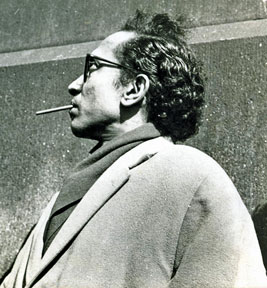The indefatigable painter
By Tissa HEWAVITARANE
Most artists who on account of parental pressures or other
circumstances begin their working lives in different professions regret
the time thus spent as time wasted. Ivan Peries was one of the rare
exceptions. He showed artistic inclinations very early. He was
profoundly interested in the right choice of materials and he very much
enjoyed the technicalities of painting.
|

Ivan Peries |
Ivan Peries was born on 31 July 1921 in Colombo. He first began art
lessons under David Painter in the early 1940s in Colombo, and in these
classes he met Aubrey Collette and developed a great friendship. Later
Lionel Wendt recommended Harry Pieris as his teacher.
This association grew into a life-long friendship. Ivan Peries
considered his guru as the finest of all teachers. In 1946 he won a
government scholarship to go to London and join St. Johnswood School of
Art for four years.
He very much enjoyed life in the school and it is there he discovered
the technique of tempara which he used frequently in his work. The
experience contributed largely towards Ivan Peries becoming such a
legend and fastidious master of the craft in his own right.
The cinema legend Dr. Lester James Peries is his brother who was
living in London in the 1940s. Lester James Peries was working as a
sub-editor in a London newspaper. He wrote to his parents about his
brother's work and that in master Russel's opinion has now the
indication of future greatness. He was the prime movere in the formation
of the '43 Group.
He had been a constant vigorous power and acted every way for the
furtherance of art in Sri Lanka. He was committed to the Group and
worked hard to make it the avant-garde of Ceylonese painting. (Returning
from London in late 1949 Ivan Peries began giving art classes at Cora
Abraham's Art School in Dickman's Road (then) Havelock Town. These
classes included formal life drawings and great deal of discussions in
the human anatomy.
Ivan Peries returned to live in London in 1953, and worked at various
jobs, as messenger, builder's mate and hospital worker to earn a living
while he continued to paint. He proved his genius by having several
one-man exhibitions in Europe. In October 1965 he had 80 paintings and
drawings at St. Chaterine's College, Oxford and 53 works at the
Commonwealth Institute Gallery in 1966.
His paintings adorned the walls of leading institutions and formed
part of several important private and national collections in many parts
of the world, including the Petit Palais in Paris.
The Martin Parsel Collection in London, Pembroke College Oxford,
Leicester Education Authority Leicester, the War Memorial Museum London
and many other art galleries in Europe. His work was exhibited and goes
as private collection at the Sapumal Foundation, and Anton
Wickremasinghe collection in Colombo.
His work had the air of a whim or fancy. His land scapes had all
sorts of themes that stimulated his imagination.
In the landscape composition he used drawings made from nature. Of
greater merit than his landscape compositions are his figure
compositions. He used golden reds and crimson glowing in a fierce
tropical sky. In the deep forebodings of the sea and the rumblings of
the monsoon equally full of awe as the painting titled 'The Return'.
There is realism in the anxiety with which the family awaits the
return of the men gone out to the sea.
Spectacular fantastic effects were part of the feeling of freedom he
enjoyed in his work. The paint is handled with absolute mastery, brushed
impatiently on to the surface and leaving the portrait tingling with
intensity and with a palpitating surface texture.
His response to portraiture was keener, more neurotic and though
restricted, capable of giving a wonderfully graceful air to noble
sitters.
Ivan Peries had the outstanding degree of craftsmanship with which to
achieve all this. He was born to a family of five members had one
brother and a sister. His father was a doctor of medicine. He died on 13
February 1988.
Tissa Hewavitarane,
www.tissahewartane.com
|

